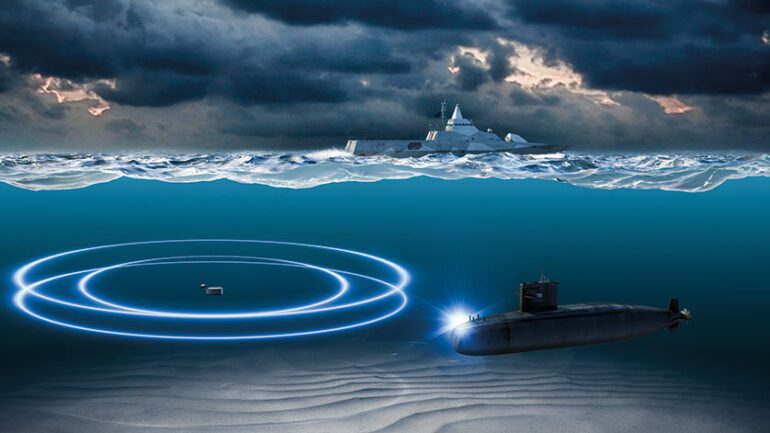TL;DR:
- Anti-submarine warfare is undergoing a transformation, with machines and AI algorithms replacing traditional sonar operators.
- Quantum sensing and robotic scouts are emerging technologies that could disrupt submarine stealth and security.
- The AUKUS alliance (Australia, UK, US) is leading in quantum technology, potentially gaining an advantage over China.
- Unmanned underwater vehicles (UUVs) are becoming increasingly important, equipped with advanced automation and AI capabilities.
- Recent collaborations between key allies and the AUKUS alliance are focusing on enhancing autonomous systems and AI applications.
- Quantum clocks offer precise timekeeping, benefiting navigation, especially when GPS signals are unavailable.
- Quantum sensors may detect subtle phenomena, but they require advanced AI algorithms to filter out false positives.
Main AI News:
In the realm of anti-submarine warfare, a paradigm shift is underway. Gone are the days of passive-sonar operators straining to detect faint traces of lurking enemy submarines while active sonar pings echo ominously. The future of this critical naval battleground belongs to machines, powered by artificial intelligence (AI) algorithms that decipher acoustic clues from a network of sensors sharing data across vast distances. Moreover, on the horizon, cutting-edge technologies like robotic scouts and quantum sensing threaten to pierce the cloak of stealth, rendering submarines vulnerable to attack.
The race to master these technologies holds immense strategic value, not only in the Arctic and NATO’s Baltic and Black Sea regions but also in the broader context of the US-China rivalry spanning the vast Pacific Ocean. Research into AI, robotics, quantum science, and anti-submarine warfare is increasingly intertwined and vital for the United States and its allies.
A spokesperson for the US Navy expressed their commitment to leveraging cutting-edge technologies, highlighting the significance of quantum technologies, such as quantum sensing, quantum timing, and artificial intelligence, for submarine detection and anti-submarine warfare. It is reasonable to assume that China’s People’s Liberation Army Navy (PLA Navy), known for its aggressive modernization efforts, shares similar aspirations. In addition to its goal of forcibly “reunifying” with Taiwan by 2027, China seeks to lead the world in AI by 2030 and has made strides in quantum science, particularly in areas like quantum key distribution.
Currently, the advantage, especially in quantum technology, lies with the AUKUS alliance, consisting of Australia, the United Kingdom, and the United States. According to Arthur Herman, director of the Quantum Alliance Initiative at the Hudson Institute, the AUKUS countries can gain an asymmetric advantage over China by integrating their quantum research and development efforts to create prototypes for testing and evaluation at sea. Much like the introduction of sonar revolutionized submarine warfare, quantum sensing has the potential to transform both manned and unmanned submarine systems.
While manned submarines traditionally receive the spotlight, unmanned underwater vehicles (UUVs) have already achieved widespread adoption. These UUVs, including the Remus 100 and 600 series, have been in service for two decades, with advanced versions featuring high levels of automation. They can operate autonomously for extended periods, offering significant advantages. Future developments in quantum sensors and sophisticated AI signal processing could enhance the capabilities of these robotic submarines, making them far more challenging for adversaries to evade.
In recent developments, key Pacific allies Australia and Japan announced a groundbreaking collaboration to enhance their capabilities in robotic and autonomous systems for undersea warfare. Similarly, the AUKUS alliance unveiled a series of research, development, and experimentation initiatives that include unmanned mini-submarines, AI algorithms for maritime patrol planes, integrated experiments with autonomous systems, AI/machine learning applications, and Quantum Positioning, Navigation, and Timing (PNT) technology.
While Australia’s procurement of US nuclear-powered attack submarines captures attention as part of “Pillar I” of AUKUS, these initiatives are integral to “Pillar II,” a broader and equally important research and development collaboration encompassing eight advanced capabilities, including quantum technologies and artificial intelligence.
Australia, despite being the world’s 12th largest economy, excels in quantum research, particularly when measured per capita. It ranks among the top five nations in various subcategories of quantum research, highlighting its prowess in this emerging field. While quantum applications are primarily confined to laboratories at present, quantum clocks have already made their mark, offering unparalleled accuracy in measuring time. Quantum clocks hold immense potential for improving inertial navigation systems, especially when GPS signals are inaccessible, such as underwater.
The next frontier in quantum science is sensing, as subatomic particles’ behavior can be remarkably sensitive to external forces. Quantum sensors have the potential to detect phenomena that traditional sonar cannot, from magnetic fields to subtle gravitational variations caused by large vessels like submarines. However, this heightened sensitivity comes with the challenge of distinguishing genuine signals from false positives. Advanced pattern-recognition algorithms, powered by artificial intelligence, offer a solution by filtering through vast datasets to identify credible contacts, a capability increasingly vital in anti-submarine warfare.
Sidharth Kaushal, a naval expert at Britain’s Royal United Services Institute, emphasizes that the issue in sub-hunting is not the shortage of high-quality sensors but the overwhelming volume of data that human operators must process. Machine learning can simplify this complex task, making hypersensitive sensors, including quantum detectors, more practical for real-world missions. The relentless progress of AI raises questions about the future of submariners, as machines continue to redefine the landscape of anti-submarine warfare.
Conclusion:
The rapid integration of AI and quantum technologies in anti-submarine warfare has significant implications for the defense market. Companies specializing in AI algorithms, quantum sensors, and autonomous systems stand to benefit from increased demand for advanced solutions in naval warfare. Additionally, there may be a shift in the market towards AI-driven defense systems, potentially reducing the reliance on human-operated submarines and increasing investments in cutting-edge technologies.

